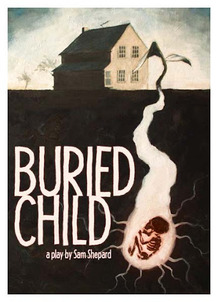Buried Child
Synopsis
In Buried Child, Shepard presents an even darker picture of the family, with long-buried family secrets serving as the basis for the inherited curse. Dodge, the head of the household, looks at the TV while curled up on the sofa with an old blanket about him. His wife, Halie, speaks at her husband (not to him) of trivial matters when she is not busy soliciting the local clergyman, Father Dewis.Tilden, their oldest son, is a mentally ill and emotionally spent semimute who repeatedly carries armfuls of corn onto stage. After having one leg amputated by a chainsaw, Bradley, the second son, now spends most of his time tussling with Dodge over the blanket and TV, or threatening to chop off Dodge's hair. Dodge denies that Bradley is his son, saying instead that his flesh and blood is buried in the backyard, in a sequence of remarks that resembles the pattern of denial found in Curse of the Starving Class.
To complicate matters, Halie frequently mentions yet another son, Ansel, who (according to Halie and Halie alone) was a hero and basketball star. Into the midst of this dysfunctional home comes Vince, Tilden’s son, who wants to reestablish his family ties, and Shelly, Vince’s girlfriend. Tilden, however, refuses to recognize Vince, claiming that the son he once had is now dead and buried.
The rejection of familial ties alludes to the psychological and physical abandonment that permeates the house in Buried Child. Physically speaking, the deceased child alludes to the child that Tilden and Halie conceived through incestuous union; Dodge killed the child and interred him in the field behind the home. The dead child is a metaphor for all of the family's offspring, who are all dead to their parents, to each other, and to themselves. Unable to receive approval from any of his ancestors, Vince one night stomps out and embarks on an alcohol binge, leaving Shelly vulnerable to Bradley's advances and threats. Once again raising the possibility that behavior is mechanically passed down from generation to generation, Vince's obvious brutality when he returns the following morning, completely inebriated, gives Halie and Dodge the clue as to who he is. Just as Tilden appears holding the excavated body of the buried child, Vince declares himself the family's new patriarch after Dodge passes away. This contrasts with depressing pictures of illness, death, and denial. The highly ambiguous conclusion of the play juxtaposes depressing imagery of denial, illness, and death with the hope represented by the rebirth of a new generation.
Real World Manifestion of the Conflict
The denial of family connections can have profound and far-reaching consequences, both on a physical and emotional level, ultimately leading to the rejection of family members and the onset of familial dysfunction. At its core, this denial often stems from unresolved conflicts, deep-seated traumas, or societal pressures that compel individuals to distance themselves from their familial roots. Psychologically, the denial of family connections can manifest as a defense mechanism, a means of self-preservation in the face of perceived threats to one's identity or well-being. By disavowing familial ties, individuals may seek to shield themselves from the pain, dysfunction, or perceived inadequacies associated with their family history.
On a physical level, the rejection of family members can result in estrangement, isolation, or outright abandonment, as individuals sever ties with those whom they perceive as a source of distress or conflict. This rejection may take the form of physical distance, such as moving away from family members or cutting off communication altogether. In extreme cases, it can lead to fractured relationships, broken bonds, and irreparable damage to the familial unit. Moreover, the physical rejection of family members can exacerbate feelings of loneliness, alienation, and disconnection, further perpetuating the cycle of dysfunction within the family dynamic.
Emotionally, the denial of family connections can give rise to a profound sense of loss, longing, or betrayal, as individuals grapple with the complexities of their familial identity. The suppression of familial ties can engender feelings of guilt, shame, or inadequacy, as individuals struggle to reconcile their desire for autonomy with their inherent need for belonging. This internal conflict can manifest in various forms of psychological distress, including depression, anxiety, or unresolved trauma, as individuals confront the emotional repercussions of denying their familial heritage. Moreover, the denial of family connections can perpetuate cycles of intergenerational trauma, as unresolved issues are passed down from one generation to the next, further exacerbating familial dysfunction and discord.

___
